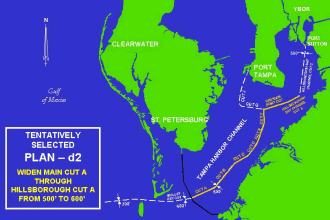Technology Enhances Safety
Much of the focus on widening the channel has been for safety reasons but new technology also is playing a critical role in preventing collisions and groundings. PORTS Ų or the Physical Oceanographic Real-Time System Ų is a system of sensors providing real-time data on currents as well as water and wind levels.
Accessible through shipboard laptop computers, PORTS had a $7 million annual impact on the Tampa Bay economy, according to a report from the National Oceanic and Atmospheric Administration (NOAA), the first study of its kind in the nation. PORTS helped prevent 50% of anticipated groundings among tankers, resulting in estimated savings of $2.8 million. It also allowed phosphate tankers to increase tonnage for a savings of $1.1 million and enabled shippers to avoid nearly $1.8 million in costs by increasing efficiency and accuracy.
The onboard laptops also are used for the vessel traffic and information system (VTIS), which links each ship to a differential GPS system that provides real-time data on other ships in the channel. Coordinating the location of other ships along with wind and current information helps to guard against collisions and groundings.
Both PORTS and VTIS are functioning in Tampa Bay, although efforts to obtain funding for improvements and ongoing maintenance has been only partially successful.

Sparkman Channel (right) runs between Harbour Island (center) and the port‚s petroleum farm (not shown) to the east. |
A Tale of Two Channels
While the process of widening the main ship channel began in 2001 and probably won‚t be complete until after the end of the decade, a small but critical widening project near Channelside in downtown Tampa started last April and will likely wrap up by the end of March, just before birds return to nest on spoil island 2-D.
Sparkman Channel, which lies between Harbour Island and the port‚s petroleum farm, leads to cruise ship terminals where approximately one million passengers embark every year.
Nearly 20 million tons of petroleum products move through the port every year, serving customers across west and central Florida. Its petroleum berths and storage facilities are so critical that the state funded 75% of the $4.6 million construction cost.
At the same time, the newer and larger cruise ships require larger safety zones, particularly when they‚re near flammable materials. „There‚s little or no margin for error,š notes Steve Fidler, the port‚s director of operations. „If the winds exceed a certain level, we‚re not able to bring a Miracle-class ship into Channelside.š
Seven times over the past 12 months, cruise ship passengers have disembarked from a cargo berth and been bused back to the main terminal. „It‚s inconvenient for passengers and they‚re not getting the experience they paid for,š adds Richard Wainio, port director.
Cruise ships bring in 25% of the port‚s operating revenues, Wainio said, and now is an important time for Tampa to attract new ships. The newest class of cruise ship Ų at 951 feet long and 201 feet high Ų won‚t fit under the Sunshine Skyway Bridge. Of the 19 ships currently under construction around the world, only two are small enough to sail into Tampa Bay.
„We need to be ready to handle additional Miracle-class ships so that when Miami and Port Everglades get the new ships, we can attract the ships they displace,š he said. „Carnival is very impressed with what we‚ve done and we believe in a year or two they‚ll bring in another ship or upgrade the Inspiration Ų but it never would have happened without a wider channel.š
Tampa Bay Ship Channel has Long HistoryThe Army Corps of Engineers has been working in Tampa Bay for more than 100 years with authorization and funding from Congress from as early as 1899. Following is a partial list of projects; for more details visit http://www.saj.usace.army.mil/digitalproject/dpn/sajn_032.htm.

|
March 3, 1899 |
Congress authorizes construction of a main ship channel in Tampa Bay, 27 feet deep and 300 to 500 feet wide from the Gulf of Mexico to Port Tampa (on the western edge of Interbay Peninsula), and a 12-foot-deep channel to the Lafayette Street Bridge in the Hillsborough River. |
Aug. 18, 1917 |
Additional funding provided for a 27-foot-deep channel from 200 to 500 feet wide in Hillsborough Bay and basins at the mouth of the Hillsborough River and Ybor Estuary. |
July 3, 1930 |
Egmont Channel dug to depths of 29 feet. |
Aug. 30, 1935 |
Authorization for channel deepening to 30 feet in Tampa Harbor. |
March 2, 1945 |
Funding provided for Alafia River channel, 25 feet deep by 150 feet wide. |
May 17, 1950 |
Funding approved to deepen Egmont Channel to 36 feet; Tampa Bay, Hillsborough Bay, Port Tampa channels to 34 feet deep by 400 feet wide. |
Dec. 31, 1970 |
Congress authorizes deepening of Tampa Bay‚s main channel to 44 feet and 500 feet wide from Mullet Key Cut to the junction of Hillsborough Bay and Port Tampa channels; Egmont Channel deepened to 46 feet by 700 feet, and Mullet Key Cut Channel to 44 feet by 600 feet. |
Nov. 17, 1986 |
Authorization for maintenance dredging at Port Manatee; channel deepened to 40 feet by 400 feet wide and turning basin enlarged. |
|
|